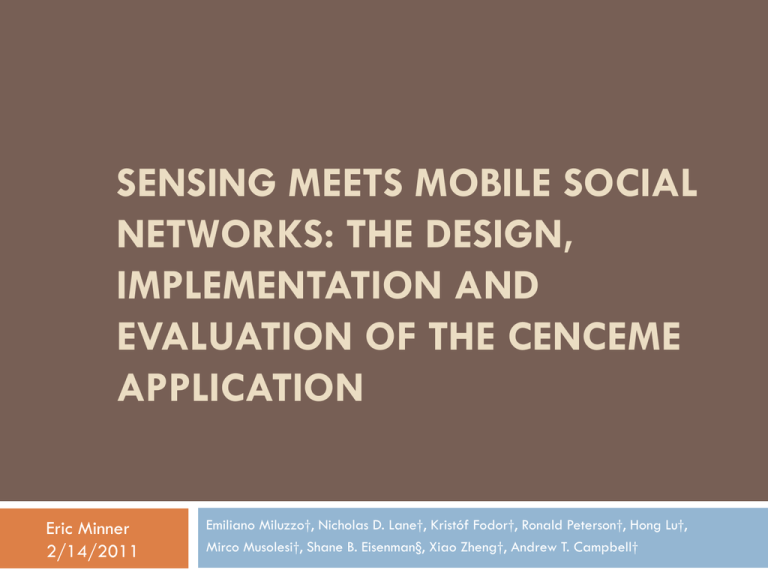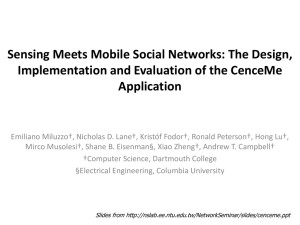SENSING MEETS MOBILE SOCIAL NETWORKS: THE DESIGN, IMPLEMENTATION AND EVALUATION OF THE CENCEME
advertisement

SENSING MEETS MOBILE SOCIAL NETWORKS: THE DESIGN, IMPLEMENTATION AND EVALUATION OF THE CENCEME APPLICATION Eric Minner 2/14/2011 Emiliano Miluzzo†, Nicholas D. Lane†, Kristóf Fodor†, Ronald Peterson†, Hong Lu†, Mirco Musolesi†, Shane B. Eisenman§, Xiao Zheng†, Andrew T. Campbell† Outline Introduction Design Considerations Implementation Classifiers System Performance User Study Conclusion Introduction Presents an implementation of a people-centric sensing application. Infers people’s presence based on mobile phone sensors. Integrated into mainstream Social Networks. Split Architecture optimized for performance and battery life of mobile devices. (Nokia N95 used for initial implementation) User study used for initial testing and optimization of performance. Design Considerations Mobile Phone Limitations Problems arise when user applications make request’s for resources. OS can deny requests for memory, CPU cycles, and other resources to place phone calls and other higher priority tasks. User applications are subject to interruption from the OS at any time. Calls for very careful development of exception handlers and recovery. Design Considerations Architectural Design Issues. Finding the right separation of what processing can be performed on the phone and what makes sense to perform offline on the backend servers. Simple classifiers make sense to perform in the phone reducing the amount of sensor data that must be pushed to the backend. Implementing a power aware duty cycle mode to improve battery life without a significant hit in the responsiveness of the system. Left static for this implementation. Implementation Mobile Device Architecture Mobile Device Sensors Bluetooth Sensor Used to sense the presence of other users MAC address checked against CenceMe database. Accelerometer Sensor Microphone Used to detect conversation. Photo Capture Used to sense motion of user. Used for still image upload to database/social network GPS Sensor Used to determine location and vehicle travel. Backend System Architecture Backend Software Apache and Tomcat servers used on the backend to interface to the mobile devices. Data exchange is accomplished through the Apache XML-RPC library. All messages are driven by the mobile device. This includes sensor data and occasional ping messages. MySQL is used as the database tool to maintain the sensor data and other primitives. Classifiers Mobile Device Audio Classifier Activity Classifier Backend Conversation Classifier Social Context Mobility Mode Detection Location “Am I Hot” Classifier (Comedic) Audio Classifier Audio classification is performed on the mobile device via an Discrete Fourier Transform(DFT) transform of the collected audio sample. Analysis of some pre recorded conversations indicated that the human voice was captured between 250Hz and 600Hz. Capture with Conversation Capture with no Conversation Audio Classifier The mean and standard deviation of the total DFT are used to correlate if conversation is occurring in the scene. A large test set was used to create the boundary line that you see to the image on the right. Activity Classifier Accelerometer data used to determine 4 main activities. Sitting, Since computed in the mobile device a simple extraction of some basic features of the XYZ vectors of the accelerometers are used. Mean, Standing, Walking, and Running. Standard Deviation, and # of Peaks. Algorithm for classification created offline based on 10 sets of test data and the above features. Activity Classifier Conversation Classifier Build upon the audio primitives generated by the mobile device. This algorithm takes a rolling window of samples from the mobile device and looks for a minimum percentage of samples that contain human voice. The threshold for confirmation of conversation is 40% of the samples. The threshold for confirming that the user is not in conversation is 80% of the samples. Social Context Uses multiple sensor data to identify the context of the scene. Tries to correlate conversation targets with neighboring CenceMe users. Looks for specific cases of partying and dancing Parses audio levels for music Looks for accelerometer readings that correlate to dancing activity(similar to running charts previously shown) Mobility Mode Detection Detects if user is travelling in a vehicle or not. Uses GPS Sensing to determine distance changes that could not be achieved with normal human speeds. Location Classifier Also uses GPS to detect the approximate location of a user. GPS coordinates fed to Wikimapia database to identify the location itself. When a location is parsed from Wikimapia the user is asked to verify the location the first time. If the information is incorrect or no information is present in the database the user is prompted to “bind” their own label on that location. “Am I Hot” Classifier Attempts to map previous user events to a stereotype. Metrics include : Nerdy Party Animal Correlated primarily with visits to museums and theatres. Healthy Based on frequency and duration in which one attends parties as well as general social interaction. Cultured Associated with spending time alone and frequent visits to libraries, etc.. Based on general high intensity accelerometer data. Greeny Based on primary method of transportation. i.e. Users are penalized for frequent use of vehicles. Performance Metrics Conversation Detection Performance Impact of duty cycle Mobile Phone Position Performance Mobile Phone Power Draw Power vs. Sensing Frequency Nokia N95 Benchmarks User Study Involved 22 candidates for a three week period who all interact on a university campus. 16 of the candidates were active Facebook users and linked their accounts. Outcome was positive by almost all users Facebook users were generally more active. Locations, random images, and social context were the features that users enjoyed the most. Feature Utilization Current Status Current versions of application exist for iPhone and iPod Touch. (Released July 2009) Supports integration with MySpace, Facebook, and Twitter. Privacy Settings Based on the User Study the main privacy concerns were giving away the users current position. Also the random photo function was met with resistance as this occurs outside of the users control. Settings to enable/disable certain sensing functions exist in the SW. Conclusion CenceMe SW does a pretty accurate job of organizing the social events associated with the user. Implementation made an ideal solution for a split mobile device/backend system. Pitfalls still exist in a few spots such as : Location and orientation of mobile device Battery life of mobile device. Development effort to integrate into larger assortment of mobile devices. Questions References http://www.cenceme.org


![[ ] ( )](http://s2.studylib.net/store/data/010785185_1-54d79703635cecfd30fdad38297c90bb-300x300.png)

